– facilities deplorable, health practices not observed
In her natural habitat the lioness is among the strongest and fastest of predators. Running as she hunts for food in the rolling grasslands of Africa keeps her healthy. At the Zoological Park in Georgetown she lies in a cage with just enough space to pace a bit.
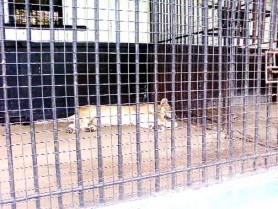
She is the only lioness there – at least the only one visible to the public – and she has no mate. Hour after hour she snoozes on the concrete floor of her small cage. She might get up to stretch occasionally, maybe move through the cage’s rear opening which leads to her private quarters for when she’s not on display, but most of the time she just lies there.
Smaller cousins of the lioness are housed in similar cages. They too seem low on energy and lazily open an eye when the occasional visitor bangs the rail or calls out to them. Bare bones remain in some cages left over from the animals’ last meal. What would these predators say if they could talk?
The monkeys are housed together in cages. They are not as lonely as the cats and perhaps because of this they seem in slightly better spirits. A lone monkey – it is not clear whether it escaped from the zoo’s caged set – jumps from cage roof to cage roof. It stops and carries out its version of chit-chat with fellow monkeys before bouncing along its way.
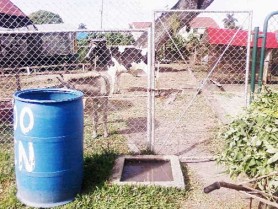
It is mid-afternoon, a sunny day and several zoo attendants can be seen moving about the compound. If they’ve noticed the free monkey they pay it no mind. One man pushes a load of grass in a wheel-barrow, another walks quickly along the path and a woman moves among the cages.
“Oy! You always,” she says. “Shut up.” She is speaking to a bird. As she continues talking to the animal she leans against the cage for a better view of it. For the next hour or so it becomes apparent that this female attendant has befriended many of the animals.
For a portion of the time she sits in a chair with her back to the cage of some parrots. She, like her colleagues, is wearing a shirt, pants and long boots. They use no gloves as they carry out tasks like clearing out cages. There are warnings to the public that the animals should not be petted, but she randomly touches some as she talks to them.
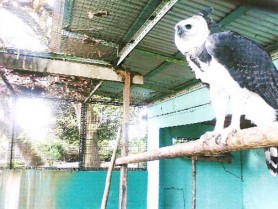
There is a shallow concrete pond in one of the larger bird cages. The water is stagnant – a nasty greenish brown – and it is obvious that it has not been changed for a while, but still the birds land in the shallow pool; it is their only water source.
Zoonoses
Johnny, the otter, lives in a caged pool almost at the end of the zoo’s path. His pool of water appears to be far better than the birds’ pond. He relaxes on the concrete rail along the sides of his square pool and often gets his head rubbed by visitors. Johnny is one of the more friendly animals; he swims alone in his small pool and welcomes the human attention.
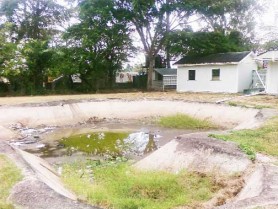
These practices can contribute to humans being infected with diseases from animals. Zoonoses is the term used to describe these diseases. Many international zoo regulations warn about zoonoses and list preventative measures.
According to the Health and Safety Executive in the ‘Managing health and safety in zoos’ report: “Even where the animals appear disease-free, their health status should be established by regular veterinary examination to identify latent infection or carriers ie infected animals showing no symptoms. In the normal course of their work, zookeepers and other employees are likely to be exposed to a variety of zoonotic infections. Visitors to zoos can also be exposed to zoonoses, particularly if they feed or handle animals. Children and the elderly are especially vulnerable. Zoo operators need to take special precautions to reduce the risk of visitors being infected.”
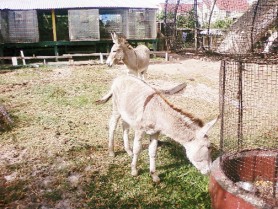
Leptospirosis and rabies are two common zoonoses. It is unclear how often the animals at the Georgetown zoo are assessed medically. Depending on the frequency of these examinations it may take some time for zoo officials to discover an unhealthy animal. Hence, both visitors and employees should take precautions at all times to minimize their risk of contracting any zoonoses.
In fact, ‘Managing health and safety in zoos’ goes on to explain that there will be activities “where the residual risk must be controlled further by the use of personal protective equipment” like gloves, masks, steel-tipped boots and plastic aprons.
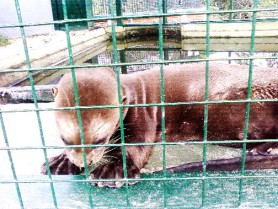
General Manager of the National Parks Commission Yolanda Vasconsellos did not comment on this and other issues. Vasconsellos spoke with Stabroek News via telephone on Wednesday and promised an interview the following day. Efforts made to
contact her on Thursday about the interview proved futile, however, and she has since failed to contact this newspaper.
Meanwhile, People for the Ethical Treatment of Animals (PETA) noted that “Most zoo enclosures are very small, and rather than promoting respect for or understanding of animals, signs often provide little more information than an animal’s species, diet, and natural range.” This is exactly what a visitor will find at the Georgetown Zoo.
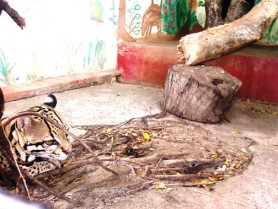
PETA further said natural hunting and mating behaviours are virtually eliminated; animals are closely confined, lack privacy, and have little opportunity for mental stimulation or physical exercise. This is evident in the case of the lioness at the Georgetown Zoo. These conditions, PETA contends, often result in abnormal and self-destructive behaviour, known as “zoochosis.”
“An Oxford University study,” PETA further contended, “based on four decades of observing animals in captivity and in the wild found that animals such as polar bears, lions, tigers, and cheetahs ‘show the most evidence of stress and/or psychological dysfunction in captivity’ and concluded that ‘the keeping of naturally wide-ranging carnivores should be either fundamentally improved or phased out.’”
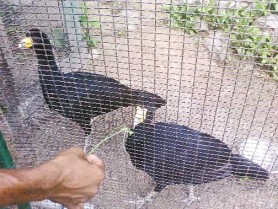
‘For the tourists from Mars’
Recently many persons have raised concerns about the state of the Georgetown zoo and the plight of the remaining animals there. Over the years, observers have reported that the number of animals at the park had decreased. In fact, while there are powerful animals like the Harpy eagle and the jaguar the Georgetown zoo still lacks variety.
On its website the Guyana Zoo claims that it “houses approximately 30 species (or kinds) of mammals, 40 species of birds, 15 species of reptiles and 20 species of fish.”
Donkeys and a cow are among the zoo’s mammals.
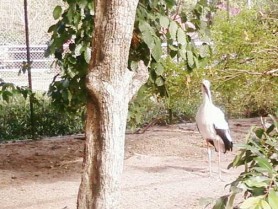
“They got to be kidding me,” a young student was overheard saying when he discovered the donkeys. “…these have to be for the tourists from Mars.”
Well, imagine their surprise when they got to the zoo’s aquarium and found fishless tanks and a few fish they had probably had for lunch recently. Several buildings in the zoo’s compound badly need maintenance. There is an abandoned building, which was once used as a medical facility; a guard hut and a rundown washroom. One of the cages has also been damaged and remains on display.
A pair of Harpy eagles is among the first sights that greets a visitor to the zoo. They are being held in a cage which doesn’t allow them any flying space. There is a third eagle which lives in a cage, which affords it more space than the others, deeper in the compound.
It will soon be six years since the Georgetown Zoo received funds to construct an aviary for the eagles. On April 11, 2003 the Mayor of the city of Odense and the Chairman of its zoo, Anker Boye, officially handed over US$30,000 towards the building of a giant cage at the back of the National Zoological Park near to where the old elephant cages were located. The aviary, Vasconcellos had said some time ago, was not constructed because the technical expertise needed was not available. She had stated that the funds were still there.
The design of the cage was expected to facilitate trees in the vicinity of the proposed construction area being incorporated into the architecture. This would have allowed for the aviary to carry the dimensions and landscaping features similar to the natural habitat of the eagles. As far as imitating an animal’s natural habitat goes, the Georgetown zoo leaves much to be desired.








